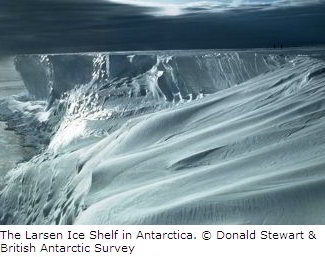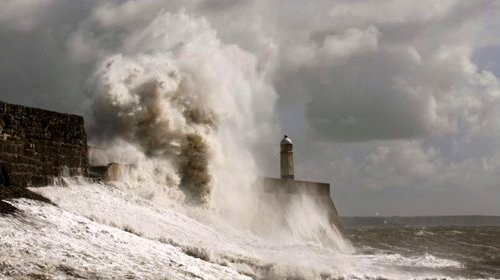 Source: British Antarctic Survey (BAS)
Source: British Antarctic Survey (BAS)
Authors: Barrand, et al.
Topic Area: Summer Melt, Sea Level Rise
Geographic Area: Antarctica
New research from the Antarctic Peninsula shows that the summer melt season has been getting longer over the last 60 years. Increased summer melting has been linked to the rapid break-up of ice shelves in the area and rising sea level.
The Antarctic Peninsula – a mountainous region extending northwards towards South America – is warming much faster than the rest of Antarctica.
Temperatures have risen by up to 3°C since the 1950s – three times more than the global average. This is a result of a strengthening of local westerly winds, causing warmer air from the sea to be pushed up and over the peninsula. In contrast to much of the rest of Antarctica, summer temperatures are high enough for snow to melt.
Aside from contributing directly to sea level rise, this summer melting may have other important effects. Meltwater may enlarge cracks in floating ice shelves which can contribute to their retreat or collapse. As a result, the speed at which glaciers flow towards the sea is increased. Also, melting and refreezing causes snow layers to become thinner and more dense, affecting the height of the snow surface above sea level. Scientists need to know this so they can interpret satellite data correctly.
Dr. Nick Barrand, who carried out the research while working for the British Antarctic Survey (BAS), led an analysis of data from 30 weather stations on the peninsula.
“We found a significant increase in the length of the melting season at most of the stations with the longest temperature records,” he says. “At one station, the average length of the melt season almost doubled between 1948 and 2011.”
To build up a more complete picture across the whole peninsula, the team (funded by the European Union’s ice2sea programme) also analysed satellite data collected by an instrument called a scatterometer. Using microwave reflections from the ice sheet surface, the scatterometer was able to detect the presence of meltwater. The team were able to produce maps of how the melt season varied from 1999 to 2009, and showed that several major ice shelf break-up events coincided with longer than usual melt seasons. This supports the theory that enlargement of cracks by meltwater is the main mechanism for ice shelf weakening and collapse.
The researchers also compared data from both the satellite and weather stations with the output of a state-of-the-art regional climate model.
Dr. Barrand, who now works at the University of Birmingham, says, “We found that the model was very good at reproducing the pattern and timing of the melt, and changes in melting between years. This increases confidence in the use of climate models to predict future changes to snow and ice cover in the Antarctic Peninsula.”
The study, “Trends in Antarctic Peninsula Surface Melting Conditions from Observations and Regional Climate Modelling”, was published in the Journal of Geophysical Research on March 28.
Source: BAS.


















